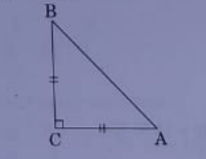If x2+px+1 is a factor of ax3+bx+c then a) a2+c2=−ab b) a2+c2ab c) a2−c2=ab d) a2−c2=−ab
A) a2+xc2=−ab
B) a2+c2=ab
C) a2−c2=ab
D) a2−c2=−ab
The correct Answer is:C
To solve the problem, we need to determine the conditions under which the polynomial x2+px+1 is a factor of the polynomial ax3+bx+c.
1. Understanding the Problem:
We know that if x2+px+1 is a factor of ax3+bx+c, then when we divide ax3+bx+c by x2+px+1, the remainder must be zero.
2. Performing Polynomial Long Division:
- We will divide ax3+bx+c by x2+px+1.
- The first term of the quotient will be a because a⋅x2=ax3.
- Multiply x2+px+1 by a:
a(x2+px+1)=ax3+apx2+a
- Subtract this from ax3+bx+c:
(ax3+bx+c)−(ax3+apx2+a)=−apx2+(b−a)x+(c−a)
3. Continuing the Division:
- Next, we take the term −apx2 and divide it by x2 to get −pa.
- Multiply x2+px+1 by −pa:
−pa(x2+px+1)=−pax2−p2ax−pa
- Subtract this from the previous remainder:
(−apx2+(b−a)x+(c−a))−(−pax2−p2ax−pa)=(p2a+b−a)x+(c−a+pa)
4. Setting the Remainder to Zero:
- For x2+px+1 to be a factor, both coefficients of x and the constant term must equal zero:
p2a+b−a=0(1)
c−a+pa=0(2)
5. Solving for p:
- From equation (2), we can express p:
pa=a−c⟹p=a−ca
6. Substituting p into Equation (1):
- Substitute p into equation (1):
(a−ca)2a+b−a=0
(a−c)2a+b−a=0
(a−c)2+ab−a2=0
a2−2ac+c2+ab−a2=0
−2ac+c2+ab=0
7. Rearranging the Equation:
- Rearranging gives us:
c2−2ac+ab=0
- This can be rewritten as:
a2−c2=−ab
Final Answer:
The correct option is:
d) a2−c2=−ab.
We know that if x2+px+1 is a factor of ax3+bx+c, then when we divide ax3+bx+c by x2+px+1, the remainder must be zero.
- We will divide ax3+bx+c by x2+px+1.
- The first term of the quotient will be a because a⋅x2=ax3.
- Multiply x2+px+1 by a:
a(x2+px+1)=ax3+apx2+a
- Subtract this from ax3+bx+c:
(ax3+bx+c)−(ax3+apx2+a)=−apx2+(b−a)x+(c−a)
- Next, we take the term −apx2 and divide it by x2 to get −pa.
- Multiply x2+px+1 by −pa:
−pa(x2+px+1)=−pax2−p2ax−pa
- Subtract this from the previous remainder:
(−apx2+(b−a)x+(c−a))−(−pax2−p2ax−pa)=(p2a+b−a)x+(c−a+pa)
- For x2+px+1 to be a factor, both coefficients of x and the constant term must equal zero:
p2a+b−a=0(1)
c−a+pa=0(2)
- From equation (2), we can express p:
pa=a−c⟹p=a−ca
- Substitute p into equation (1):
(a−ca)2a+b−a=0
(a−c)2a+b−a=0
(a−c)2+ab−a2=0
a2−2ac+c2+ab−a2=0
−2ac+c2+ab=0
- Rearranging gives us:
c2−2ac+ab=0
- This can be rewritten as:
a2−c2=−ab
The correct option is:
d) a2−c2=−ab.
Topper's Solved these Questions
- QUADRATIC EQUATIONS BOOK - VIKAS GUPTA (BLACK BOOK) ENGLISHCHAPTER - QUADRATIC EQUATIONS EXERCISE - EXERCISE (ONE OR MORE THAN ONE ANSWER IS/ARE CORRECT)
42 Videos
- QUADRATIC EQUATIONS BOOK - VIKAS GUPTA (BLACK BOOK) ENGLISHCHAPTER - QUADRATIC EQUATIONS EXERCISE - EXERCISE (COMPREHENSION TYPE PROBLEMS)
23 Videos
- PROBABILITY BOOK - VIKAS GUPTA (BLACK BOOK) ENGLISHCHAPTER - PROBABILITY EXERCISE - Exercise -5 : Subjective Type problems
11 Videos
- SEQUENCE AND SERIES BOOK - VIKAS GUPTA (BLACK BOOK) ENGLISHCHAPTER - SEQUENCE AND SERIES EXERCISE - EXERCISE (SUBJECTIVE TYPE PROBLEMS)
21 Videos
Similar Questions
Factorise a2−2ab+b2−c2
View SolutionFactorise : (ii) 35a3b2c+42ab2c2
View SolutionFactorise : 2ab2c−2a+3b3c−3b−4b2c2+4c
View SolutionFactorise : ab2−(a−c)b−c
View SolutionIf the roots of the equation x3+3ax2+3bx+c=0 are in H.P., then (i) 2b2=c(3ab−c) (ii) 2b3=c(3ab−c) (iii) 2b3=c2(3ab−c) (iv) 2b2=c2(3ab−c)
View SolutionIf ∣∣−aa2abacab−b2bcacbc−c2∣∣ =ka2b2c2 , then k is equal to
View SolutionFactorise completely : a2+2ab+b2−c2
View SolutionDivide :
4a2+12ab+9b2−25c2 by 2a + 3b + 5c
View Solutionin figure, ABC is an isosceles traingle, right angled at C. therefore

a) AB2=2AC2
b) BC2=2AB2
c) AC2=2AB2
d) AB2=4AC2
View SolutionIf a, b, c are positive integers such that a2+2b2−2ab=169 and 2bc−c2=169 then a + b + c is:
View Solution
